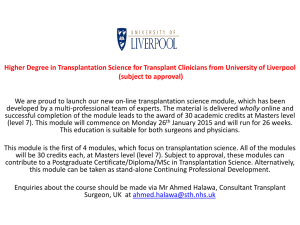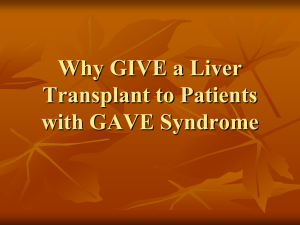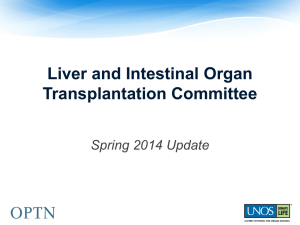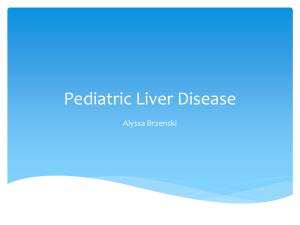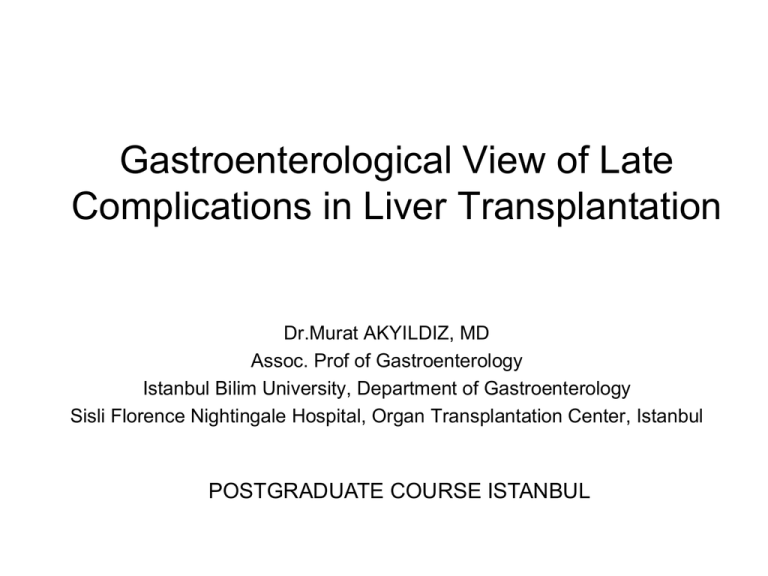
Gastroenterological View of Late
Complications in Liver Transplantation
Dr.Murat AKYILDIZ, MD
Assoc. Prof of Gastroenterology
Istanbul Bilim University, Department of Gastroenterology
Sisli Florence Nightingale Hospital, Organ Transplantation Center, Istanbul
POSTGRADUATE COURSE ISTANBUL
Case-1
• 67 years-old woman was admitted to hospital
with acute coronary syndrome
• She was hospitalised in intensive care unit and
coronary angiography revealed LAD and main
coronary artery disease
• Cardiovascular surgery unit decided to perform
CABG operation and preoperative consultation
from hepatology unit performed since she was
liver transplant recipient.
• Medical History
– She had decompansated liver cirrhosis because of HCV
and living donor liver transplantation was performed in
2007.
– She had CNI nephrotoxicity after
switched to sirolimus monotherapy
the first year and
– PEG-INF plus ribavirin was given since HCV RNA was
positive and stage 2 fibrosis at 1 year
– There was no response to treatment and PEG-INF was
discontiniued at 6 moth of therapy
– Aleondrate plus calcium and vit D for osteoporosis were
given for 3 years
– Amlodipine plus ramipril was given for hypertension and
using insulin during last 2 years.
• Physical Examination
– There was 1 cm
splenomegaly,
– pretibial eodema (+),
– no icter, no ascites
– Blood pressure 150/90
mmHg, HR 90/R
• Lab
–
–
–
–
–
–
–
–
–
–
–
–
–
–
–
Glucose fasting 140 mg/dl,
HbA1C 7.8
Tryglycerid 280 mg/dl
Cholesterol 320 mg/dl
HDL 40 mg/dl
LDL 180 mg/dl
BUN 40 mg/dl
Cr 2 mg/dl
AST 80 IU/ml
ALT 90 IU/ml
T. Bil 1 mg/dl
Albumin 4 g/dl
PLT 120 000/mm3
Hb 10 g/dl
WBC 3500/mm3
• Diagnosis
– Liver Transplant Recipient (2007, LDLT)
– Recurrent HCV infection
– Hypertension
– Tip 2 diabetes mellitus
– Coronary artery disease
– Chronic renal failure, CNI nephrotoxicity
Introduction-1
• Orthotopic liver transplantation (OLT), is now the best treatment for
selected patients with end-stage liver disease, hepatocellular
carcinoma or acute liver failure.
• OLT currently has a 5-year survival of 70–80% and generally
provides a good quality of life.
– Roberts MS et al. Survival after liver transplantation in the United
States: a diseasespecific analysis of the UNOS database. Liver Transpl
2004:10; 886–897
• Most life-threatening complications associated with OLT occur within
the perioperative period
–
–
–
–
primary graft dysfunction,
acute rejection episodes,
severe infections
technical complications such as hepatic artery thrombosis or biliary
leaks.
Introduction-2
• Outcome after orthotopic liver transplantation
has improved continuously over the past 15
years
• The recognition and prevention of long-term
complications after transplantation have become
ever more important
• Physicians should be aware of the risk of late
and chronic rejection episodes and of recurrence
of the underlying liver disease after LT
• The major challenge of posttransplant care is
– To prevent and manage the long-term adverse
effects of the immunosuppressive medications.
– Screening investigations for early diagnosis of
malignancy
– strict control of cardiovascular risk factors,
– preservation of renal function
– prevention of infections
Objectives
• Describe the cumulative incidence of renal
failure after LT.
• Describe the incidence of cardiovascular
risk factors and metabolic bone disease
after LT.
• Describe the most common nonhepatic
malignancies occurring after LT
• Describe the primary disease recurrence
and de-novo liver disease after LT
Renal Dysfunction
• One of the most common complications after LT.
• Chronic CNI toxicity, which causes structural changes to
the renal parenchyma, is the main cause of renal failure,
but other causes have to be ruled out.
• The cumulative incidence of renal impairment in more
than 69,000 nonrenal transplant recipients, (defined as a
glomerular filtration rate of <30 ml/min/1.73m2)
– 8.0% at 1-years
– 13.9% at 3-years
– 18.1% at 5 years after transplantation
• Ojo AO et al. Chronic renal failure after transplantation of a nonrenal
organ. N Engl J Med 2003; 349: 931–940
Risk Factors For Renal Dysfunction
• Pretransplant renal dysfunction
• Nephrotoxic drugs
• Pretransplant hepatorenal
syndrome
• Postoperative acute renal failure
• Duration of renal dysfunction
prior to liver transplantation
• Renal replacement therapy
requirement in the pretransplant
or posttransplant period
• Calcineurin induced
nephrotoxicity
• HCV infection
• Hypertension
• Diabetes mellitus (preexisting
or new onset DM after liver
transplantation)
• Older age
Recommendations for CNI Nephrotoxicity
• Reduction or withdrawal of CNI
• Conversion to MMF or sirolimus based protocols
• Aggressive management of diabetes mellitus
• Control blood pressure
• Avoid toxic drugs and contrasts
Objectives
• Describe the cumulative incidence of renal
failure after LT.
• Describe the incidence of cardiovascular
risk factors and metabolic bone disease
after LT.
• Describe the most common nonhepatic
malignancies occurring after LT
• Describe the primary disease recurrence
and de-novo liver disease after LT
Cardiovascular Risk Factors
• Liver transplant recipients have a higher risk of
cardiovascular death and ischaemic events as
compared with an age- and sex-matched
population without liver transplant
– 9% at 5 years post-transplant
– 25% at 10 years post-transplant
• Cardiovascular disease causes 21% of deaths
among liver transplant patients with functioning
grafts surviving more than 3 years
Risk factors for cardiovascular complications
Cardiovascular
complication
Incidence
(%)
Risk factors
Hypertension
31–82
Cyclosporine>tacrolimus,
Glucocorticoids
Hyperlipidaemia
29–50
Sirolimus and glucocorticoids>Cyc >TAC
Diabetes mellitus
10–64
Glucocorticoids,
Tacrolimus>cyclosporine.
Hepatitis C, cytomegalovirus,male gender
Obesity
22–64
Glucocorticoids,
greater recipient BMI,
greater donor BMI,
being married,
absence of acute cellular rejection,
Family history of diabetes/arteriosclerotic
heart disease//hypertension
Arterial hypertension-1
• Definition
– Sistolic BP>140 and/or diastolic BP>90
– Prehypertension
• sistolic BP 120-129 mmHg or diastolic BP 80-89
• The incidence was ranges from 50% to 70%.
– with cyclosporine, can occur in 58–82% of patients
– with tacrolimus, in 31–38% of patients.
• Risk factors for development of hypertension
– Calcineurin inhibitor immunosuppressive therapy
– pre-existing or worsening renal disease
– obesity
Arterial Hypertension-2
• The mechanism underlying CNI-induced hypertension is
vasoconstriction of systemic and renal vessels by various
mechanisms
– cyclosporine stimulates renin release and causes upregulation of
angiotensin II receptors in vascular smooth muscle
– leading to a decrease in glomerular filtration and enhanced
sodium re-absorption in the renal tubules
– calcineurin inhibitors, especially cyclosporine, may also directly
impair normal vasodilating systems by reducing prostacyclin and
nitric oxide production
– mediate systemic vasoconstriction directly by leading to increased
thromboxane and endothelin release
– prolonged therapy with cyclosporine has also been shown to lead
to chronic sympathetic overactivity
• Glucocorticoid leads to hypertension via multiple
pathways
– activate the renin–angiotensin system,
– reduce activity of depressor systems such as nitric
oxide and prostaglandins,
– increase pressor responses to angiotensin II and
norepinephrine,
– increase the number of angiotensin II receptors on
vascular smooth muscle cells.
• So, the net effect of these changes promotes systemic
vasoconstriction leading to the development of
hypertension.
Arterial hypertension-3
• Targets for treatment of patients
– DM or renal disease absent <140/90
– DM or renal disease present <130/80
• Target blood pressure levels should be
<130/80mmHg in order to minimize the risk
for cardiovascular events
Arterial hypertension-4
• First of all standard advice should be given to all
patients highlighting the importance of adequate
exercise and the avoidance of smoking and
alcohol.
• Additionally, lifestyle modifications such as
weight loss in overweight individuals and
restricting sodium intake reduce blood pressure
Arterial Hypertension-4
• Modifications of immunosuppressive therapy
can help control hypertension
– Conversion from cyclosporine to tacrolimus
– Switching from a calcineurin based regimen
consisting of either cyclosporine or tacrolimus to a
regimen consisting of mycophenolate mofetil or
sirolimus decreases hypertension
– Mycophenolate mofetil may be combined with lowdose calcineurin inhibitors to improve hypertension
while providing adequate immunosuppression and
decreasing the risk of rejection
– Steroid medication should be minimized and
withdrawn as soon as possible after liver transplant
Arterial Hypertension-5
• Long-acting calcium channel blockers that are not metabolized
through CYP3A4—such as amlodipine,but not diltiazem or
verapamil—are often used as first-line agents in OLT recipients
• Angiotensin-converting enzyme inhibitors or angiotensin receptor
blockers are also very effective, especially in patients who have
diabetes mellitus and/or proteinuria, but should be aware of the
possibility of hyperkalemia
• In patients nonresponsive to single agent therapy, calcium channel
blockers can be combined with ACE inhibitors or ARBs
• Studies comparing ACE inhibitors, calcium channel blockers, and
beta blockers, specifically lisinopril, amlodipine and bisoprolol, in
liver transplant recipients showed that
– lisinopril and amlodipine were more effective than bisoprolol
• β-Blockers that are selective for the β1 adrenoceptor can also be
given, but their effect can be less marked.
Dyslipidemia-1
• Hypercholesterolaemia and hypertriglyceridaemia both commonly
occur in liver allograft recipients.
– Hypercholesterolaemia is prevalent in 51–66% of liver transplant
patients
– hypertriglyceridaemia occurring in up to 50% of patients
• Lipid profiles should be check at least biannuly
• Sirolimus and glucocorticoids are associated with higher rates of
dyslipidaemia as compared with cyclosporine and tacrolimus.
• Sirolimus is heavily associated with hyperlipidaemia and has been
reported to cause hypercholesterolaemia in 44–55% of patients
– alters the insulin signalling pathway to increase adipose tissue
lipase activity and decrease lipoprotein lipase activity, thereby
resulting in increased hepatic synthesis of triglycerides and
increased secretion of very low-density lipoprotein (VLDL).
Dyslipidemia-2
• Glucocorticoids
– increase activity of acetyl-CoA carboxylase, free fatty acid
synthetase and HMG CoA reductase, leading to elevated VLDL,
total cholesterol, and triglycerides and reduced high-density
lipoprotein (HDL)
• Cyclosporine is associated with moderate rates of
dyslipidaemia, with hypercholesterolemia found in 30%
of patients and hypertriglyceridaemia found in 33% of
patients.
– reduces the conversion of cholesterol to bile salts and decreases
activity of lipoprotein lipase, thereby resulting in increased VLDL
and lowdensity lipoprotein (LDL) levels
• Tacrolimus has similar effects to cyclosporine but is
associated with a lower prevalence of hyperlipidaemia
Dyslipidemia-3
• Risk factors for the development of dyslipidemia
– Steroids,
– CNIs,
– mTOR inhibitors,
– post-transplant diabetes mellitus,
• Dietetian consultation and lifestyle modifications help the
normalization of lipid profiles
• Immunosuppressive therapy modifications such as
– conversion from cyclosporine to tacrolimus,
– decreased prednisone usage,
– minimization of sirolimus usage all assist in the
normalization of cholesterol levels.
Dyslipidemia-4
• Treatment with statins is indicated in patients who have an LDL
cholesterol level greater than 100–130 mg/dl despite taking
dietary measures and implementing lifestyle changes.
• Pravastatin or fluvastatin do not undergo metabolism by CYP3A4
and select those as first line treatment for hyperlipidemia. On the
other hand, atorvastatin and simvastatin are the other lipid
lowering agents which should be used lower dosage and titrated
up slowly sınce the toxicity risk
• When comparing statins with fibrates, it appears that lovastatin
more effectively reduces total cholesterol and LDL levels, while
gemfibrozil more effectively lowers triglyceride levels.
Dyslipidemia-5
• In patients who remain dyslipidaemic on statin therapy alone, a
fibrate medication should be added to improve control of
hyperlipidaemia.
• Fibrates should be used with caution and are contraindicated in
patients with renal failure
• Monitoring levels of the muscle enzyme creatine kinase and liver
tests for side effects
• In order to avoid statin toxicities in patients on immunosuppressive
therapy, statins should be started at the lowest possible dosage and
titrated up slowly, with close monitoring of the patient for side
effects.
• Combination therapy comprising statins and the cholesterol
absorption inhibitor ezetimibe ban be used safely.
Diabetes Mellitus
• The general prevalence of diabetes is as high as 31–38% in the posttransplant population
• New onset diabetes is found in 13–28% of liver transplant recipients
more than 1 year after transplantation
• Before liver transplantation, patients should be screened for diabetes
for proper risk stratification of cardiovascular morbidity.
• After liver transplantation, patients should undergo diabetes screening
on a regular basis, at weekly intervals for the first month after
transplant, at 3, 6 and 12 months after transplant, and on an annual
basis thereafter
• Patients diagnosed with diabetes should hae HbA1c levels measured
every 3 months, with a goal HbA1c level of o7%.
Diabetes Mellitus
• Risk factors for DM
–
–
–
–
–
–
Male gender
CMV infection in the first year of transplantation
Obesity
HCV
CNI (TAC>Cyc, (17 vs 10% )
Steroid therapy
• Pre-existing and new-onset diabetes mellitus is associated with
–
–
–
–
–
–
–
increased cardiovascular morbidity and mortality,
the development of renal dysfunction,
a higher incidence of fatal infections,
more rejections,
impaired graft survival, an increased risk of graft failure and death
microvascular complications, retinopathy and nephropathy,
an increased risk of developing hypertension and coronary artery
disease and neurologic complications
Diabetes Mellitus
• Strict glycaemic control is important in order to
reduce the long-term complications of diabetes.
• Treatment of post-transplant diabetes includes
–
–
–
–
limiting caloric intake,
a low carbohydrate diet,
appropriate exercise,
pharmacological therapy with oral hypoglycaemic
agents and insulin as needed
– Immunosupressıve modifications
• steroid withdrawal
• reducing the CNI dose,
• switching from tacrolimus to the less diabetogenic agent
cyclosporin
Obesity
• Obesity is defined as a body mass index (BMI) >30
kg/m2,
• UNOS database has shown that 54% of liver
transplant recipients were considered overweight or
obese
• After liver transplant, the incidence of obesity ranges
from 18 to 64% of patients
• Post-transplant weight gain is significantly greater in
patients over 50 years old and those transplanted for
chronic liver disease as compared with fulminant
hepatic failure.
Nair S, Verma S, Thuluvath PJ. Obesity and its effect on survival in patients undergoing orthotopic liver
transplantation in the United States. Hepatology 2002; 35: 105–9.
Obesity
• Many transplant centers will encourage weight loss
before transplantation.
• Elevated preoperative BMI in liver transplant recipients
predisposes to increased surgical complications
– Wound infections
– Respiratory failure
– Sytemic vascular problems
• UNOS database have shown that morbidly obese
patients (BMI >40 kg/m2)
– have significantly higher rates of primary graft nonfunction,
– higher rates of immediate, 1-year, and 2-year mortality
– 5-year mortality was significantly higher both in severely obese
(BMI 35–40 kg/m2) and morbidly obese patients.
Nair S, Verma S, Thuluvath PJ. Obesity and its effect on survival in patients undergoing orthotopic liver
transplantation in the United States. Hepatology 2002; 35: 105–9.
Obesity
• Pre-transplant predictors of the post-transplant obesity
–
–
–
–
higher recipient BMI,
higher donor BMI
being married
absence of acute cellular rejection (unknown mecanism,
probably having improved overall appetite with increased oral
intake)
– Higher cumulative prednisone dose
• Patients who are overweight after liver transplant also
more commonly have a
– family history of diabetes mellitus,
– family history of arteriosclerotic heart disease,
– family history of hypertension
LTx at the extremes of BMI
( 73538 patients from UNOS Database )
Patient survival according to BMI
LTx at the extremes of BMI cont.
• BMI < 18.5 more likely to die from
hemorrhagic complications ( P<0.002)
and CVA (P<0.004)
• BMI > 40 died of infectious complications
and cancer events ( P=0.02)
– Liver Transplantation 15: 968-977, 2009
Obesity
• Recommendations for obesity
– Weight loss should be recommended for all patients
before undergoing liver transplantation, especially
patients with a BMI >35 kg/m2.
– obese patients should be encouraged to limit caloric
intake and engage in regular physical activity.
– glucocorticoid should be withdrawn as soon as
possible after LT
– Orlistat, (pancreatic and gastric lipase inh) can be
used safely, decreases waist circumference, but not
in weight or body mass index in obese liver transplant
recipients.
Metabolic Bone Disease
• The cumulative incidence of fracture is
– 14-50% at 1 year
– 24-55% at 2 years after LT
• Before LT
– Decreased bone density is common ( 68%) in cirrhotic
patients
– Vitamin D level deficiency (92%) hypogonadism 41% of
patients
– Lifestyle modifications
• such as smoking cessation and weight-bearing exercise
should be encouraged
• Vit D 800 IU/day and calcium 1000 mg/day in low vit D
levels
Risk Factors for Fracture After LT
• Pre-TX factors
–
–
–
–
–
–
Older age
Female sex
Poor nutritional status
Low pre-TX BMD
Osteoporotic fractures
Cholestatic liver disease
• Post-TX factors
–
–
–
–
Dose of steroid
Cyclosporin
Low pre-TX BMD
Rejection episodes
• Independent Risk factors
– Pre-TX
• Low BMD
• Cholestatic liver
disease
• Osteoporotic fractures
in pre-transplant
– Post-TX
• Cumulative dose of
steroid
• Low BMD after LT
• Fall in BMD after LT
Management of Osteoporosis-1
• Nonpharmacologic therapies include
– ETOH and smoking cessation,
– increased physical activity
– a balanced diet with 1500 mg of calcium and 800 IU of vitamin D
daily.
– Steroid should be stopped as soon as possıble
• Studied pharmacologic treatments include
– Testosterone replacement in male patients with low serum
testosterone levels,
– replacement of additional vitamin D (25 000–50 000 IU orally two
to three times per week) if a deficiency is present
– Bisphosphonates
• Check BMD after 2 year of treatment
– If no response to treatment
– add bisphosphonates in patients receiving HRT
– in patients already receiving bisphonates switch to strontium
Management of Osteoporosis-1
• Pain control with transdermal fentanyl and
metamizole is important for the fast rehabilitation
oral
• Avoid administration of selective and nonselective
NSAIDs due to their nephrotoxicity and association with
acute renal failure
Metabolic Bone Disease
• Osteonecrosis of the Femoral Neck
– Another important metabolic bone disease
after LT
– presents as hip pain due to corticosteroid use.
– diagnosed by magnetic resonance imaging
(MRI)
– require hip replacement.
Infections
• The frequency and localization of infections in the long
term generally resemble in the general population,
– with upper respiratory tract infections and urinary tract
infections being most common after the first 6 months of LT
• Cholangitis should be considered in LT recipients who
have a fever of unknown origin,
– The risk for recurrent cholangitis is particularly high in patients
with biliodigestive anastomosis
– biliary strictures following transplantation
• The initial diagnostic algorithm for fever of unknown
origin in OLT recipients in the long term is similar to
that used for nontransplant patients, but should be
performed early and thoroughly.
Infections-2
• Empiric treatment with antibiotics is recommended if patients show
clinical signs of infection and levels of inflammatory parameters are
elevated.
• Attention should be paid to potential interactions between the
antimicrobial agent and the CNI
– macrolide antibiotics should be used with great caution as they
considerably increase a patient’s exposure to the CNI and can cause
renal failure.
– Hepatotoxicity potential should be kept in mind
– Nephrotoxicity potential should be kept in mind
– Quinolones are usually a good choice because they do not interfere with
the effects of CNIs and are effective against cholangitis, most bacterial
respiratory infections,and urinary tract infections.
• When patients do not respond to antibiotic treatment, a thorough
work-up is mandatory,since the possibility of
– tuberculosis,
– opportunistic infections
– post-transplant lymphoproliferative disorders (PTLDs).
CMV
• Liver recipients at highest risk of CMV infection and disease are
those who have never had CMV infection until they receive a
latently infected organ from a CMV-seropositive donor (CMV
D+/R- mismatch).
• The risk of progression into CMV disease is increased by the
intense immunosuppression required to avoid or to treat allograft
rejection.
• CMV pp65 antigenemia or CMV DNA by polymerase chain
reaction) as the earliest indicators of infection.
• Intravenous ganciclovir (5 mg/kg every 12 h) or oral valganciclovir
(900 mg orally twice daily), combined with reduction in
immunosuppression.
Treatment of CMV Disease
• serial weekly monitoring of viral load or antigenemia levels.
• The vast majority of CMV disease cases
transplantation remain susceptible to ganciclovir.
after
liver
• Non-responders should be tested for drug resistant virus, with
UL97 and UL54 gene sequencing.
• Foscarnet and cidofovir are often used for treatment of
ganciclovir-resistant UL97-mutant CMV strains, but they have a
high risk of nephrotoxicity
Eid AJ, Razonable RR. Drugs 2010; 70: 965-981
Sun HY, Am J Transplant 2008; 8:2111-2118
Kotton CN, et al. Transplantation 2010; 89: 779-795
De novo malignancies-1
• Transplant recipients are generally at higher risk than the general
population for the development of de novo malignancies or the
recurrence of previous cancers.
• The incidence has been reported to be as 1.5–26.5%.
• Nonmelanoma skin cancer and PTLD are by far the most common
malignancies in OLT recipients.
• Human herpes virus 8 is a central etiological factor in the
development of Kaposi sarcoma
De-novo malignancies-2
• Cutaneous malignancies, especially SCC, develop at a younger
age, are more aggressive, metastasize and tend to be multiple
in transplant recipients than those in the general population.
• The peak incidence of cutaneous malignancies is 3–5 years
after organ transplantation
• Risk factors for SCC after organ transplantation
–
–
–
–
–
a history of skin cancer and/or actinic keratosis,
fair skin,
chronic sun exposure and/or sunburn,
older age, duration and intensity of immunosuppression,
history of HPV infection, and CD4 lymphopenia.
• Patients at high risk for SCC require close monitoring before
and after LT
• Effective sun protection and annual examination of the skin by
an expert dermatologist is, therefore, highly recommended
De-novo malignancies-3
•
PTLDs mainly result from primary or reactivated EBV.
•
The cumulative 5-year incidence of PTLD in OLT recipients was 1.5%.
•
Risk factors for the development of PTLD include
– negative pretransplant Epstein–Barr virus serology, which is common in
children,
– over immunosuppressive therapy using polyclonal or monoclonal T-cell
antibodies.
•
Most cases of PTLD develop during the first year after transplantation
•
Diagnosis is established according to the results of biopsy of lymph nodes
or affected organs.
•
Treatment of PTLD involves,
– withdrawal of CNIs.
– In vitro studies and case reports suggest that the use of mTOR inhibitors can
lead to regression of lymphoma and, in addition, offers safe prevention of graft
rejection.
– monoclonal B-cell antibodies (e.g. rituximab),
– radiation or chemotherapy
De novo malignancies-4
• Be aware of the risk of
– high incidence of colon cancer in OLT patients who
have ulcerative colitis or PSC
• annual colonoscopies are necessary
– high incidence of esophageal and oropharyngeal
cancer in patients who undergo transplantation for
alcoholic cirrhosis
• Whether other common types of cancer such as vulva,
cervix, breast, renal and prostate cancer also occur more
frequently in OLT recipients than in the general
population is still not clear,
Liver Disease Recurrence and De-novo Liver Disease
Journal of Hepatology 2011;55: 702–717
Journal of Hepatology 2011;55: 702–717
Natural History of Recurrent Hep C
• Recurrence is universal with 20-40% progression to
cirrhosis in 5 years
• Annual liver biopsy to be considered due to lack of
sensitivity and specificity of ALT. More risk of fibrosis
after 5 years
• More than F1 fibrosis should be considered for PegIFN+Ribavirin treatment.
• Immunosuppression is the only modifiable factor and
awaits better clinical trials for appropriate power and
duration (? antiviral effect of CYA in HCV replicon
models)
• Said A & Lucey MR, Current Opinion in Gastro 2008, 24:339-345
N.A. Terrault Liver Transplantation 14:S58-S66, 2008
De-novo Liver Disease
• Patients who are transplanted for one type of
primary liver disease and subsequently
develop features suggesting a different primary
liver disease.
– viral infection hepatitis B and C
– AIH
– non-alcoholic fatty liver disease (NAFLD).
De-novo AIH
• A higher frequency has been reported in children (5–
10%) compared with adults (1–2%),
• Most cases present >1 year post-LT and respond well to
increased immunosuppression, but some have
progressed to cirrhosis or graft failure
• Autoantibodies are frequently present without signs of
graft dysfunction, particularly in the paediatric population
and liver biopsy is, therefore, required to determine the
nature of any damage present.
– anti-GSST1 antibodies
– antibodies to cytokeratin 8/18
– atypical LKM antibodies to carbonic anhydrase III or subunit
beta1 of proteasome
– the de novo development of antibodies to the bile salt export
pump (BSEP) protein, in children who became cholestatic
following transplantation
Histological features closely resemble those occurring with AIH in the native
liver and recurrent AIH in the liver allograft.
They include a plasma-cell rich mononuclear portal inflammatory infiltrate
associated with varying degrees of interface hepatitis
Lobular inflammation and necrosis tend to be more prominent than in the
native liver and can include features of central perivenulitis
De novo non-alcoholic fatty liver disease (NAFLD)
• The distinction between recurrent and de novo NAFLD
is often difficult.
• Risk factors
–
–
–
–
–
diabetes mellitus and insulin resistance
weight gain,
hypertension, and hyperlipidaemia
steatosis in the donor liver
HCV
• Patients who were transplanted for cryptogenic
cirrhosis and/or had risk factors for the metabolic
syndrome prior to transplantation and could thus be
regarded as having recurrent rather than de novo
disease
De novo non-alcoholic fatty liver disease (NAFLD)
• Interactions between hepatitis C infection, insulin
resistance and NAFLD also appear to be important in the
pathogenesis of recurrent HCV and de novo NAFLD
• Histologic features
– Fatty change, apparently unrelated to recurrent disease, is
present in 18–40% of post-transplant biopsies and a common
finding in protocol biopsies obtained from patients with normal
liver function tests
– Steatosis is mainly macrovesicular and usually mild in severity.
– Features of steatohepatitis, also typically mild in severity, are
present in 1–13% of cases.
– Perisinusoidal fibrosis was present in 29% of patients with de
novo NAFLD in one study
Summary
• Long-term mortality after liver transplantation mainly
results from
– complications associated with the use of immunosuppressive
drugs
– the recurrence of the underlying liver disease
• Management of the metabolic adverse effects of IS
drugs after LT is essential for a good long-term outcome
• Patients should undergo regular tumor screening since
the increased risk of malignancies in LT recipients
• Multidisiplinary approach is mandatory

